Undoubtedly the most famous Indian Scout is the motorcycle belonging to New Zealander Burt Munro, of the movie, The World’s Fastest Indian.
He bought it in 1920, one of the original Scouts – which were said to have a top speed of around 55 mph – and fiddled with it for the next 40-plus years, making numerous runs at the Bonneville Salt Flats in the 1960s.
A dash of history starts here: beginning in 1920 the Scout had a 600cc, 42-degree, side-valve V-twin engine, with two cams, one for each set of valves. The three-speed transmission was bolted to the back of the crankcase, with gears easing the passage of power from crankshaft to transmission shaft. The engine/gearbox sat in a full-cradle, double-loop frame, the standard of chassis design back then, with a rigid rear and a leaf-spring front suspension.
In 1927 the engine was enlarged to 750cc, and the model was called the Scout 101. There were actually two Scouts that year, the original 600cc and a 750 in a longer frame called the 101, which was known for its excellent handling. In ’32, with the Great Depression cutting deeply into sales, Indian tried to save money by bolting the 750 engine into the frame of the bigger Chief. The consumers were not happy with this heavier Scout, and let dealers know they wanted the 101 back.
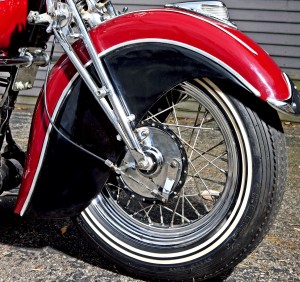
There were also smaller Indians, like the 500cc Scout Pony, which used a very different chassis from the Scout and Chief. The Pony’s front suspension had a girder fork with a single helical spring, or as Indian called it, a truss-type fork with spiral spring suspension. The key point may have been the keystone frame, designed by Indian’s Chief Engineer, Briggs Weaver, in which the engine became a stressed member.
In ’33 Indian came out with a new model called the Motoplane, which went the other direction, as the 750 engine was stuffed into the 500 frame. However, the chassis was not quite up to the 20 horsepower (estimated) of the 750. The Motoplane lasted only one year. Biggest news for the engine was that it was called a “dry sump,” as the oil was recycled instead of dripping onto the roads (which were becoming increasingly paved) as in the old constant-loss system.
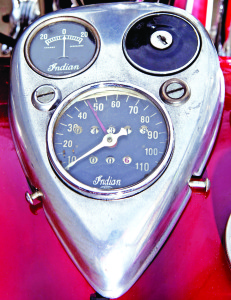
Back to the drawing board. Weaver realized the value of the Scout name, and the Sport Scout came into being in 1934. This was powered by the 750cc flathead V-twin engine fed by a Schebler carb. Plugs were fired via an automotive-type distributor, and lights lit by an Auto-Lite generator. A three-speed gearbox used a hand-shift and foot-clutch, with a triplex primary chain running to a multi-plate dry clutch at the transmission end. Throttle positioning was a buyer’s choice, available on either left or right handlebar end, with the gear-shifter on the opposite side. Folklore has it that the left-hand throttle was for right-handed policemen who wanted to be able to draw and fire while on the move. In truth it was due to the fact that American motorcycling public had not fully decided where the throttle should be.
The Sport Scout used the Motoplane’s front suspension, but the new chassis–still the keystone variety–was longer and stronger, with a wheelbase of 56.5 inches and no rear suspension of course, just rigid. Wheels were 18-inchers, with single-leading shoe brakes at each end. There were some complaints from the 101 crowd, as the old bike weighed 370 pounds, the new Sport Scout 385 pounds, but all-in-all the new bike was a superior machine. And the styling was new, with more flare to the fenders and a redesigned gas tank. The engine could easily be stroked to 935cc by using Chief flywheels.
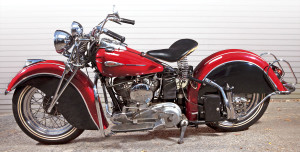
The Indian vs. Harley competition was in full glory, and Indian was out to take the checkered flag with the new model. Ed Kretz took the honors at the first-ever Daytona 200 race in 1937, and that served to sell a lot of Scouts. The next year Kretz won the inaugural 200-mile race at Laconia, in New Hampshire. Straight-line speed was a good selling point, and in 1937 a Sport Scout was clocked at 128.57 mph at Muroc Dry Lake in southern California. In September 1938, Indian-mounted Fred Ludlow set both 750cc and 1,200cc records at Bonneville.
Taking advantage of this, Indian came out with the Bonneville model in 1939, the name attached to both Sport Scouts and Chiefs. No engineering of great note was involved, but the engines were more carefully prepared, with longer-duration cams, higher compression pistons, and optional magneto ignition.
Weaver decided that Indians needed a distinguishing characteristic to separate them from the Harleys, and went all out with those big skirted fenders in 1940. Today the fenders are considered a treasure, but back then there were those who liked them, and those who did not. Many Indian lovers threw them in the trash and mounted more conventional styles.
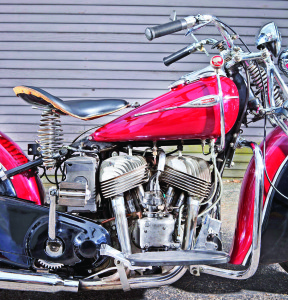
In 1941 the Sport Scout got the plunger-type rear suspension that the Chiefs had been given the year before, also referred to as “coil compression and rebound,” and offering less than two inches of travel. It was a small step forward in the development of spring frames, but a step nevertheless
Indian was also familiar with riders wanting to accessorize their motorcycles, and sold lots of farkles to keep them happy and the company solvent, as solvency was badly needed at the end of the Depression. This Bonneville Scout in the pictures, fully accessorized, is one of the very last off the production line in early ’42 before the military needed everything.

Two follow-ups. Immediately following World War II Indian built only the Chiefs, and 50 Scouts intended solely for AMA racing–on one Floyd Emde did the company proud by winning the 1948 Daytona 200. And Burt Munro, over in New Zealand, though getting on in years wanted to pit his own much, much modified Scout against the clocks at Bonneville. His first trip over here was in 1962, at the tender age of 63, with his original side-valve 600cc engine enlarged to 850cc, using overhead valves, and bolted into a homemade streamliner. He reached 162 mph that year, and kept on coming back, doing new work on the engine. Finally in 1967, with the engine bored and stroked to 950cc, his Scout ran a smooth 190.07 mph…a noble ending for a legendary name.
Year/Model: 1942 Indian Sport Scout
Owner: David Anderson, Chicago, Illinois
Photography by John Boehm, Words by Clement Salvadori
(This motorcycle was featured in the Retrospective column in the May 2012 issue of Rider magazine.)

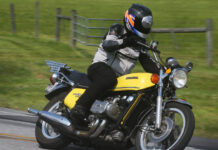




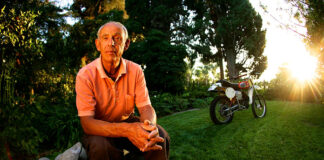


Hey i have the same motorcycle …in model form 1942 …red all the same …how much would u say its worth…it was owned by a racecar driver…just was weird it is identical to that bike
A lot !
I had a 1941 Sports Scout in 1966. At the time, it was just an interesting old bike, and it didn’t cost much: $300.00 then-maybe $3,000 in today’s money. It was a lot of fun, and very rugged and reliable.